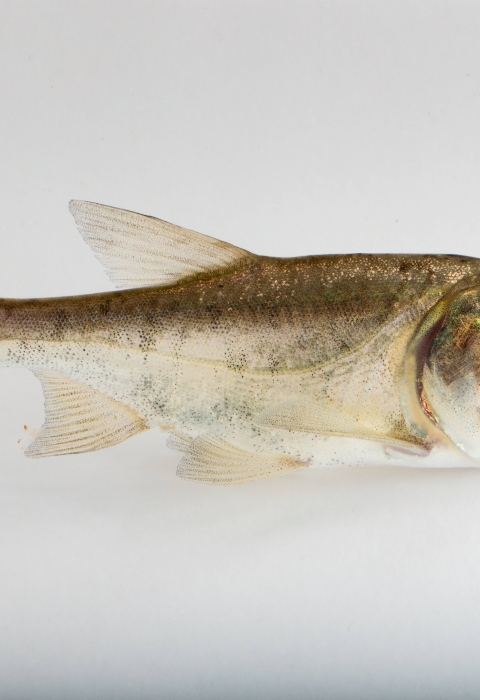Invasive carp have taken the Mississippi River basin by storm since their escapement from farm ponds in the 1970s, where they were originally introduced to control vegetation and phytoplankton and improve water quality. Like many successful invasive species invasive species
An invasive species is any plant or animal that has spread or been introduced into a new area where they are, or could, cause harm to the environment, economy, or human, animal, or plant health. Their unwelcome presence can destroy ecosystems and cost millions of dollars.
Learn more about invasive species , silver, bighead, grass, and black carp are notorious for their hardiness, prolific nature, impressive dispersal abilities, and competitive edge against native species. Bigheaded carp (silver and bighead carp) in particular, are extremely efficient planktivores capable of inducing an ecosystem collapse, as plankton serve as a primary food source for all larval fishes, many macroinvertebrates, and adult planktivores like the American paddlefish and clupeids. As researchers have scrambled to characterize the life history, limiting factors, and behavior of these fishes in non-native waters, invasive carp continue to upset the literature and further expand their range and extent.
For nearly two decades, exhaustive studies and experimental control efforts have continued in the northern half of the Mississippi River basin, where infamous hordes of leaping silver carp have earned the center stage for fisheries agencies. In recent years, however, an influx of resources has been allocated to the invasion front: the southern sub-basins. Here, all four species have persisted largely under the radar in low densities, slowly expanding their numbers and scope. With the goal of developing proactive strategies for preventing further dispersal and managing populations, state and federal agencies, conservation groups, universities, commercial and recreational fishers, and other stakeholders joined forces to begin the evaluation phase for invasive carp in Mississippi, Louisiana, Texas, Arkansas, Oklahoma, Kansas, and Missouri.
About 80 miles north-northeast of Dallas at the Texas-Oklahoma border lies the Denison Dam which forms Lake Texoma, which boasts a renowned recreational striped bass fishery attracting millions of anglers annually. If you look just below the dam though, you’ll see the unremarkable Red River as it flows through vastly untamed timber forests, multi-generational hay farms and cattle ranches, and towns you won’t find on a map. This section of the river is characterized by its extreme hydrological fluctuations from the dam, sandy reaches, inaccessibility, and nearly non-navigable nature.
It is here that the Oklahoma Fish and Wildlife Conservation Office (OKFWCO) staff began their battle against invasive carp as part of a multi-agency effort. At the inception of their newfound invasive carp work in 2020, the presence of adult bighead and silver carp on the Red River below the Denison Dam in Texas and Oklahoma was known; however, no population demographics, distribution, or abundance information was available. Where did these adult fish originate from? Are these fish spawning below the dam, in small tributaries, or are they even spawning at all? How many are present in the system? Finding accurate answers quickly is vital to the development of effective management strategies.
To determine whether invasive carp are successfully spawning on the Red River below the Denison Dam, OKFWCO biologists have spent the past two spring/summer seasons sampling for the presence of invasive carp larvae. To target eggs and freshly hatched larvae drifting in the river’s current, ichthyoplankton nets with a fine mesh were deployed on each side of the boat at varying depths as the vessel is faced upstream. LED light traps—often used to capture small phototactic fishes and invertebrates—were also set in tandem with one sampling the surface of the water and the other a foot or more below the surface. These traps are an excellent method for catching later-stage larval and juvenile fishes that are more mobile.
OKFWCO biologists spent the 2022 field season sampling sections of the Red River, spanning approximately 130 unforgiving river miles of the Red River and its tributaries. In total, one hundred fifty-three samples were collected. When a sample was collected, it was stored in 95% non-denatured ethanol which was drained and replaced within 24-hours. Three 1-mL aliquots of ethanol were collected from each sample to be tested for invasive carp genetic material, similar to an eDNA sample. This will allow biologists to prioritize which samples are processed first to streamline sample identification. This extra step is a necessity, as the OKFWCO office contains only three staff members and larval fish identification is extremely time-consuming.
Another method for answering spawning-related questions is to do necropsies on adult invasive carp that are donated by anglers. When we get these fish, we take general morphometric measurements, extract otoliths, and collect and enumerate eggs from females. These data will inform us of the demographics of this population of invasive carp as well as the reproductive stage of the fish throughout the year.





